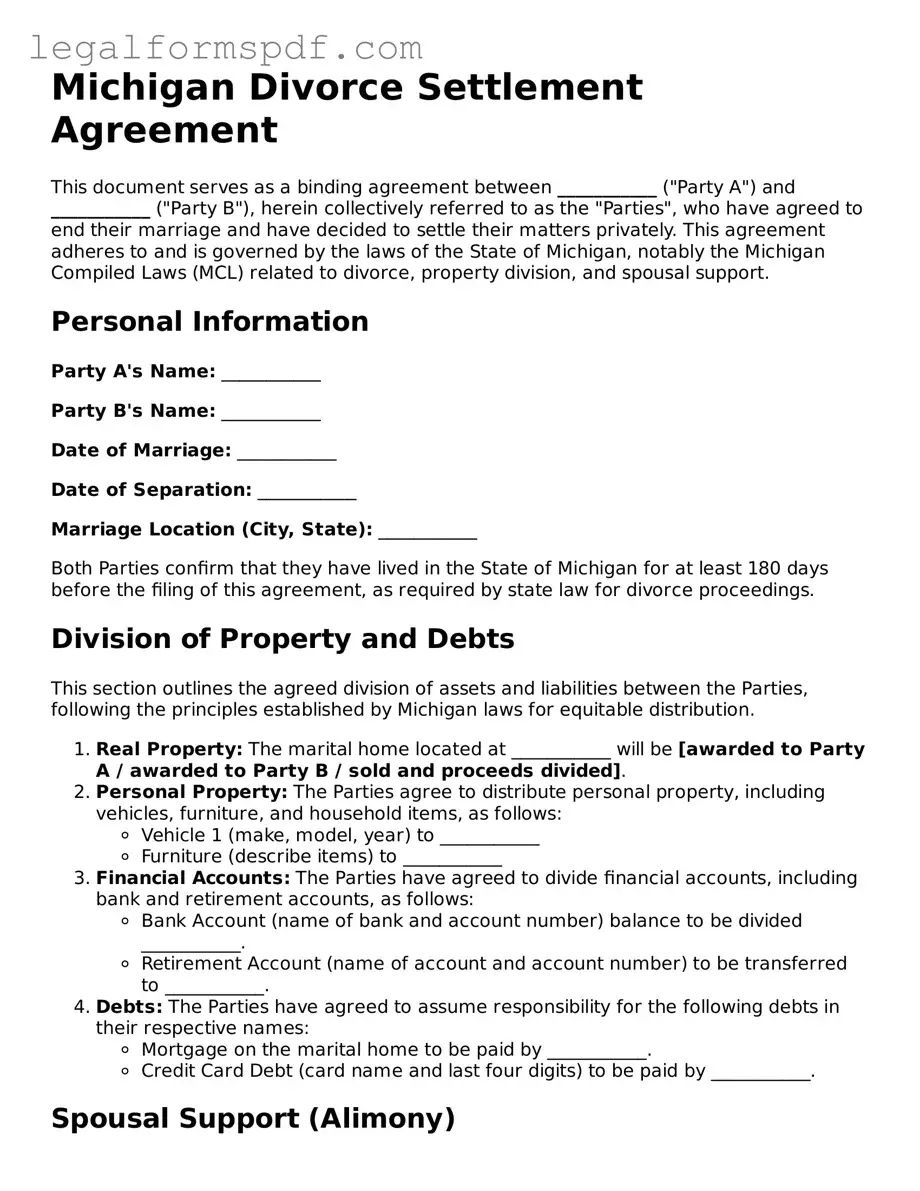Michigan Divorce Settlement Agreement
This document serves as a binding agreement between ___________ ("Party A") and ___________ ("Party B"), herein collectively referred to as the "Parties", who have agreed to end their marriage and have decided to settle their matters privately. This agreement adheres to and is governed by the laws of the State of Michigan, notably the Michigan Compiled Laws (MCL) related to divorce, property division, and spousal support.
Personal Information
Party A's Name: ___________
Party B's Name: ___________
Date of Marriage: ___________
Date of Separation: ___________
Marriage Location (City, State): ___________
Both Parties confirm that they have lived in the State of Michigan for at least 180 days before the filing of this agreement, as required by state law for divorce proceedings.
Division of Property and Debts
This section outlines the agreed division of assets and liabilities between the Parties, following the principles established by Michigan laws for equitable distribution.
- Real Property: The marital home located at ___________ will be [awarded to Party A / awarded to Party B / sold and proceeds divided].
- Personal Property: The Parties agree to distribute personal property, including vehicles, furniture, and household items, as follows:
- Vehicle 1 (make, model, year) to ___________
- Furniture (describe items) to ___________
- Financial Accounts: The Parties have agreed to divide financial accounts, including bank and retirement accounts, as follows:
- Bank Account (name of bank and account number) balance to be divided ___________.
- Retirement Account (name of account and account number) to be transferred to ___________.
- Debts: The Parties have agreed to assume responsibility for the following debts in their respective names:
- Mortgage on the marital home to be paid by ___________.
- Credit Card Debt (card name and last four digits) to be paid by ___________.
Spousal Support (Alimony)
Under Michigan laws, specifically the Michigan Spousal Support (Alimony) Laws, the Parties agree to the following terms regarding spousal support:
- Party A shall pay to Party B the sum of ___________ dollars ($____) per month for a period of ___________ years/months, starting from ___________.
- These payments will terminate upon the death of either Party or if Party B remarries, whichever occurs first.
Child Custody and Support
If the Parties have children from the marriage, they agree to the following terms regarding custody and support, in compliance with the Michigan Child Custody and Support Laws:
- Legal Custody: [Joint / Sole] custody will be granted to [Name], allowing them to make legal decisions regarding the child(ren)'s welfare.
- Physical Custody: [Primary / Shared / Sole] physical custody is awarded to [Name]. A detailed parenting time schedule is attached as Exhibit A.
- Child Support: According to the Michigan Child Support Formula, [Party A / Party B] shall pay the sum of ___________ dollars ($____) per month for child support, starting from ___________.
Signature Section
This Agreement is voluntarily entered into by both Parties and is a representation of their intent to amicably resolve matters regarding their divorce. By signing below, each Party agrees to the terms and conditions set forth in this document.
Party A's Signature: ___________ Date: ___________
Party B's Signature: ___________ Date: ___________
Witness's Signature (if applicable): ___________ Date: ___________
